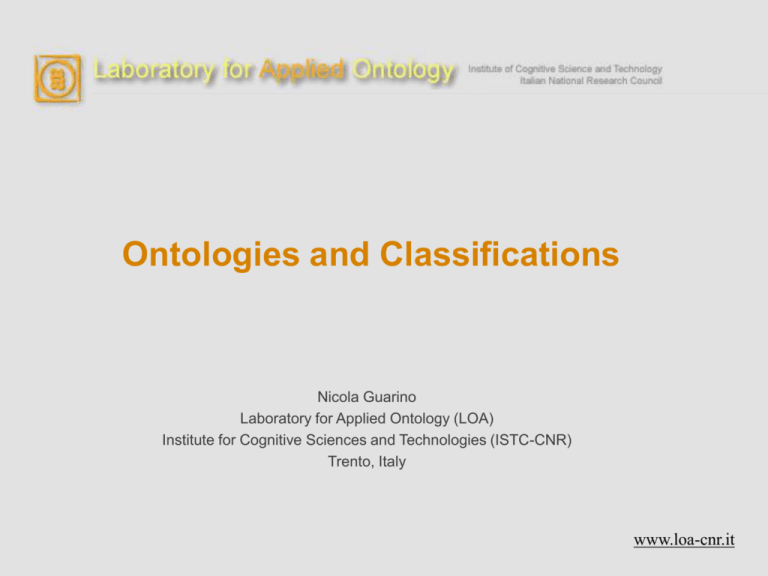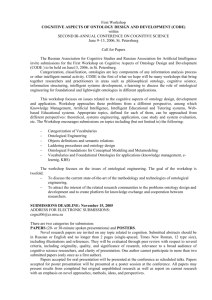Ontologies and
advertisement

Ontologies and Classifications
Nicola Guarino
Laboratory for Applied Ontology (LOA)
Institute for Cognitive Sciences and Technologies (ISTC-CNR)
Trento, Italy
www.loa-cnr.it
Summary
•
Classifications have a central role within information architecture
•
Proper use of classifications requires understanding their terms
•
Especially in presence of multiple, heterogeneous classifications
•
Main role of [computational] ontologies is to clarify the meaning of terms
•
Therefore, “ontology” is not just a trendy name for “classification”
Ontologies and classifications
play complementary roles
in information architecture
2
Functions of classifications
• Support information retrieval and analysis.
• partition the search space on the base of pre-determined
criteria
(encoded by syntactic keys)
• Provide triggers for action.
4
A simple classification
Pictures
Home
Work
Italy
Vacations
Europe
What’s the meaning of these terms?
What’s the meaning of arcs?
…they do not represent analytic relationships!
5
The source of all problems:
different languages, different
conceptualizations
A first solution: glossaries and thesauri
• Glossaries: link terms to concepts, described informally by
glosses
• Thesauri: add structural relationships (generalization, part,
dependence, causation…) among terms (and concepts).
• Multilingual glossaries and thesauri are available for many
domains.
• General thesauri (e.g., WordNet) are available for many
languages
7
Standard glossaries and thesauri can help,
but...
•
Defining standard vocabularies is difficult and time-consuming
•
Once defined, standards don’t adapt well
•
Heterogeneous domains need a broad-coverage vocabulary
•
People don’t implement standards correctly anyway
•
Vocabulary definitions are often ambiguous or circular
•
Accessing and integrating heterogeneous glossaries and thesauri
becomes a nightmare
8
The need to focus on CONTENT
The key problems
• content-based information access (semantic matching)
• content-based information integration (semantic integration)
•
To approach them, content must be studied, understood, analyzed
as such, independently of the way it is represented.
•
Computer technologies are not really good for that (focus is usually on
representation and reasoning)
•
A strong interdisciplinary approach is needed
9
What is an ontology
Ontology, lexicon, semantics
• Distinctions among contents: Ontology (capital ‘o’)
• Reference to content: Lexicon, via Semantics
• Every organization, every computer system
• Makes (implicit) ontologic assumptions
• Adopt a certain lexicon, to which an intended semantics is
ascribed.
11
Ontology and Ontologies
•
Ontology: the philosophical discipline
•
•
Study of the nature and structure of being qua being
(content qua content)
ontologies:
Specific (theoretical or computational) artifacts
expressing the intended meaning of a vocabulary
in terms of primitive categories and relations describing
the nature and structure of a domain of discourse
Gruber: “Explicit and formal specifications of a conceptualization”
12
What is a conceptualization
•
The implicit rules used to structure reality as perceived and organized by
an agent, independently of:
•
•
•
the vocabulary used
the actual occurence of a specific situation
Different situations involving same objects, described by different
vocabularies, may share the same conceptualization.
LE
apple
same conceptualization
LI
mela
13
An example: the concept of red
a b
{a}
{b}
{a,b}
{}
14
Conceptualization
Perception
relevant invariants
across situations:
D,
State of
State of
affairs
Perceived
affairs
(selects D’D and ’)
Interpretations
I
Intended
models for
each IK(L)
Phenomena
situations
Ontological commitment K
Language L
Reality
Models MD’(L)
Bad
Ontology
~Good
Ontology
Ontology models
Ontology Quality: Precision and Coverage
Good
High precision, max coverage
BAD
Max precision, limited coverage
Less good
Low precision, max coverage
WORSE
Low precision, limited coverage
17
Why precision is important
Possible
interpretations of
“apple”
Farmer’s ontology
Company’s
ontology
Area
of false
agreement!
What “apple”
means for the
farmer
What “apple”
means for the
juice company
18
Ontologies and...
Levels of Ontological Precision
tennis
football
game
field game
court game
athletic game
outdoor game
game(x) activity(x)
athletic game(x) game(x)
court game(x) athletic game(x) y. played_in(x,y) court(y)
tennis(x) court game(x)
double fault(x) fault(x) y. part_of(x,y) tennis(y)
game
athletic game
court game
tennis
outdoor game
field game
football
Taxonomy
Glossary
Catalog
game
NT athletic game
NT court game
RT court
NT tennis
RT double fault
Thesaurus
Axiomatic
theory
DB/OO
scheme
Ontological precision
20
Ontologies and taxonomies
analytic relationships among terms!
21
Ontologies vs. classifications
• Classifications focus on:
• access, based on pre-determined criteria
(encoded by syntactic keys)
• Ontologies focus on:
• Meaning of terms
• Nature and structure of a domain
22
Ontologies vs. Database Schemas
• Database schemas:
• Constraints focus on data integrity
• Relationships and attribute values out of the DoD
• Typically non-executable
• Ontologies:
• Constraints focus on intended meaning
• Relationships and attribute values first class citizens
• Typically executable
23
A single, imperialistic ontology?
• An ontology is first of all for understanding each other
• ...among people, first of all!
• not necessarily for thinking in the same way
• A single ontology for multiple applications is not necessary
• Different applications using different ontologies can co-exist and cooperate (not necessarily inter-operate)
• ...if linked (and compared) together by means of a general enough
basic categories and relations (primitives).
• If basic assumptions are not made explicit, any imposed, common
ontology risks to be
• seriously mis-used or misunderstood
• opaque with respect to other ontologies
24
Which primitives?
The role of ontological analysis
•
Theory of Essence and Identity
•
Theory of Parts (Mereology)
•
Theory of Wholes
•
Theory of Dependence
•
Theory of Composition and Constitution
•
Theory of Properties and Qualities
The basis for a common ontology
vocabulary
Idea of Chris Welty, IBM Watson Research
Centre, while visiting our lab in 2000
25
The semantic web architecture [Tim Berners Lee 2000]
QuickTime™ and a
TIFF (Uncompressed) decompressor
are needed to see this picture.
26
Formal Ontology
•
Theory of formal distinctions and connections within:
• entities of the world, as we perceive it (particulars)
• categories we use to talk about such entities (universals)
•
Why formal?
• Two meanings: rigorous and general
• Formal logic: connections between truths - neutral wrt truth
• Formal ontology: connections between things - neutral wrt reality
27
When is a precise (and well-founded)
ontology useful?
1. When subtle distinctions are important
2. When recognizing disagreement is important
3. When careful explanation and justification of ontological commitment
is important
4. When mutual understanding is more important than interoperability.
28
Role of ontologies in information architecture
(thanks to Dagobert Soergel)
• Relate concepts to terms. Clarify their meaning by providing a
system of definitions.
• Provide a semantic road map and common conceptual reference
tool across different disciplines, languages, and cultures
• Make medical concepts clear to social science researchers and vice versa…
• Improve communication. Support learning by helping the learner
ask the right questions
• Support information retrieval and analysis
• Support the compilation and use of statistics
• Support meaningful, well-structured display of information.
• Support multilinguality and automated language processing
• Support reasoning.
29
Conclusions
• In general, classifications are not ontologies
• Some classifications are ontologies
• Ontologies are needed to understand, integrate, reason on
classifications
• Every ontology induces a classification
• Both ontologies and classifications are a fundamental tool for
information architecture
30
A new journal: Applied Ontology
Editors in chief:
Nicola Guarino
ISTC-CNR
Mark Musen
Stanford University
IOS Press
Amsterdam, Berlin,
Washington, Tokyo, Beijing
www.applied-ontology-org






